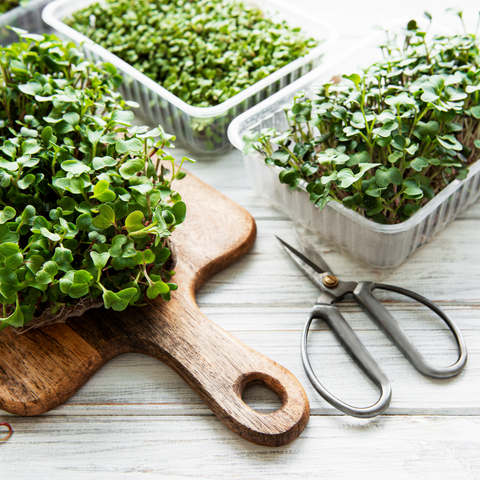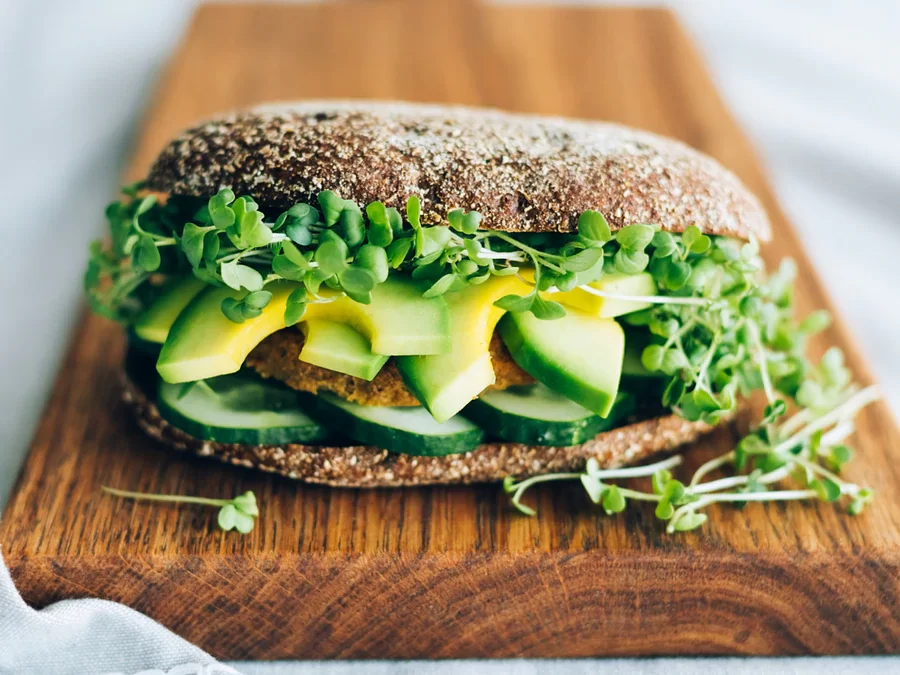About Microgreens

Not quite a green, not yet a sprout. Microgreens are young seedlings of vegetables and herbs that get harvested when they’re only 1-3 inches tall. After only 2-3 weeks microgreens are harvested for their concentrated nutrients and robust flavours.
Depending on the variety, microgreens can have up to nine times more nutrients than mature vegetables! A great way to get your daily dose of copper, iron, magnesium, zinc, potassium, calcium, vitamin C…the list goes on!
Microgreens can be enjoyed cooked but are mostly prepared raw to keep their full nutritional value. A few tasty ways to enjoy microgreens are on sandwiches, salads, smoothies, burger toppings, pizza toppings, salsas and more!
Varieties of Microgreens

Whether you’re looking to add a spicy, sour, peppery or bitter taste to your dishes, microgreens come in a wide variety of flavours and variations. To help you discover what each microgreen has to offer, we’ve created a helpful cheat sheet that’s full of flavour profiles and nutrients.
Variety |
Flavour |
Nutrients |
| Alfalfa | Nutty & mild flavour with a crunch. | Rich in vitamins A, B, C, E & K. calcium, folic acid, magnesium, phosphorus, potassium, sodium, and zinc. |
| Arugula | Softly sweet, tangy, peppery, nutty and earthy. | Rich in vitamins A, B, C, and E, as well as calcium, iron, magnesium, niacin, phosphorus, potassium, and essential amino acids. Arugula microgreens contain up to 25% protein! |
| Beets | Mild spinach-like flavour. | Rich in Vitamin B6, C, Folate, Iron, Magnesium, Manganese, potassium and copper. |
| Brown Mustard | Intense flavour with some heat. | Rich in vitamin B6, A, C, E, Omega-3, Fatty Acids, Copper, Phosphorus, Folate, Manganese, Zinc, Folate, Niacin, Iron, Potassium, Calcium. |
| Chard | Softly salty, earth with hints of veggie flavour. | Rich in vitamins K, A, C, full of protein, dietary fiber, and antioxidants. |
| Cilantro | Citrus and grassy flavour. | Rich in vitamins A, B, C, E, K, Calcium, Iron, Potassium and Zinc. |
| Mung Bean | Slightly sweet flavour similar to green peas. | Rich in vitamin B, C, K and high in fiber. |
| Fenugreek | Refreshing, spicy, grassy, curry-powder-like. | Rich in vitamin A, C, high in fiber, folic acid and thiamine. |
| Green Peas | Fresh, crunchy, slightly bitter. | Rich in vitamin C, A, high in fiber, |
| Radish | Peppery, radish-like taste. | Rich in vitamin c, B1, B6, copper, iron, magnesium, folate, zinc, dietary fiber. |
| Red Clover | Mild and fresh, nutty and sweet. | Rich in vitamin A, B-12, C, E and K. High in protein, minerals, iron, magnesium and silicon. |
Planting Microgreens

Growing microgreens at home can be a fun experience for everyone including kids! Each variety includes its growing instructions and conditions. Though, for the most part, microgreens love bright sunlight and plenty of water. Microgreens take up very little space, making the kitchen or windowsill a popular place to grow them.
1.) Container – Using a shallow container with drainage, fill the bottom with a few centimeters of seedling soil.
Note: Be sure to use sterilized soil to prevent pathogens and mold.
2.) Sowing – If planting small seeds, sprinkle seeds evenly on top of the soil. Medium-large seeds should be inserted into the soil, lightly covered by soil and evenly spaced.
3.) Water – Using a mister, soak the seeds well from above. Alternatively, seeds can be soaked from the bottom in the sink and removed to drain. Keep microgreens consistently moist, not wet.
Harvesting Microgreens

Microgreens are fast growers. In just 2 weeks you’re ready to harvest your first batch! Although regrowth isn’t likely, the leftover matter from growing microgreens is highly nutritious for other plants. To harvest your microgreens, it’s important to know the difference between True Leaves and Cotyledons.
Cotyledons are the surface embryos of microgreens that look similar to baby leaves. These can be harvested but will produce much less. True Leaves are the final form of the leaf that resembles a fully developed leaf. For a healthy harvest, cut your microgreens when they form True Leaves. Be sure to cut the bottom of the stem to get as much as you can.
Do not allow your microgreens to develop munch longer after the plant develops its True Leaves. Microgreens will overdevelop, turning yellow, losing their flavour and nutrients.
Storing Microgreens

Once you have cut your microgreens, you can expect to keep them happy and healthy in the fridge for up to 2 weeks! Plenty of time to add them to sandwiches, salads, smoothies and more! All you have to do is place them in a baggie or container with a wet paper towel to keep them hydrated. Looking for more microgreen options? Check out our new Microgreen collection here.


